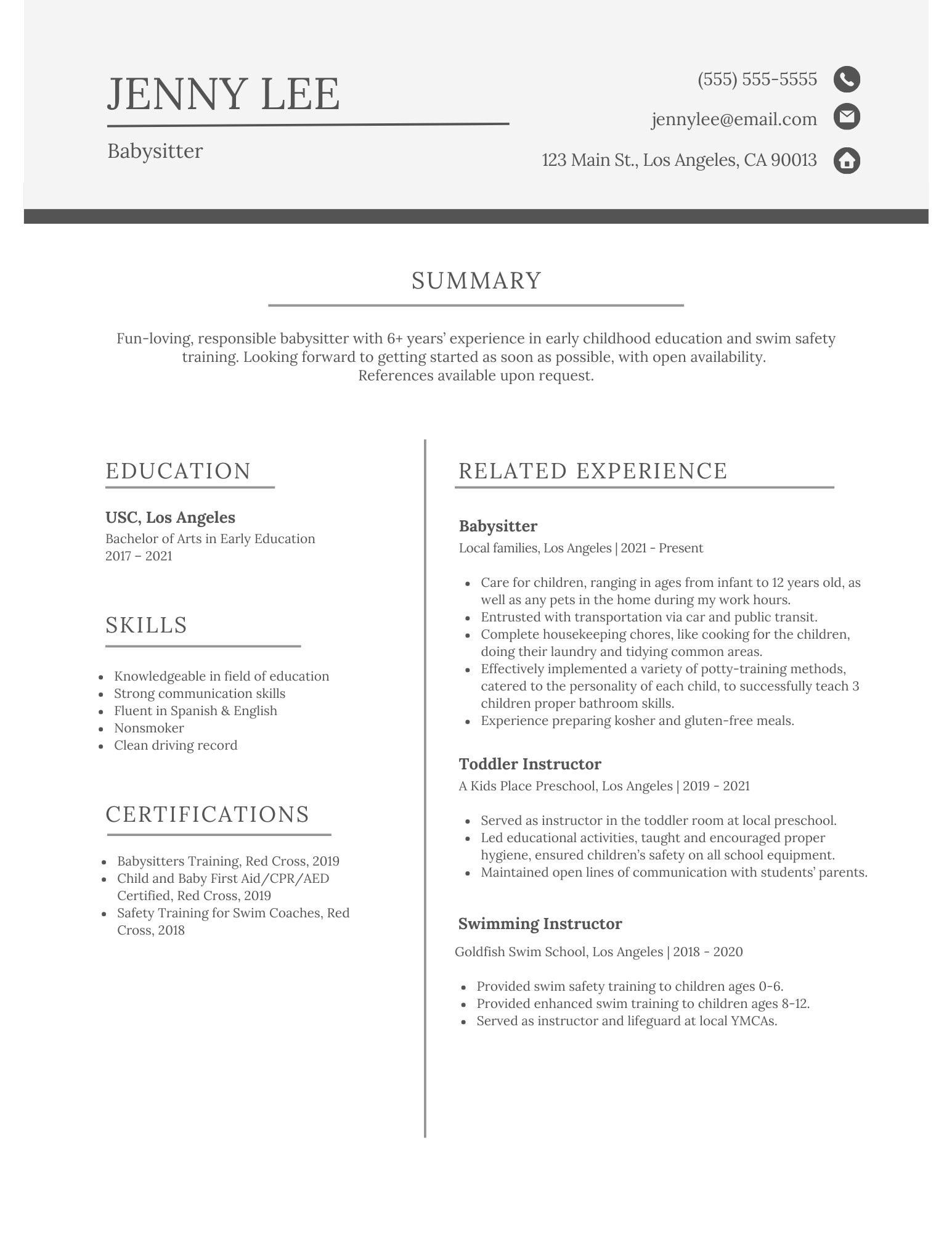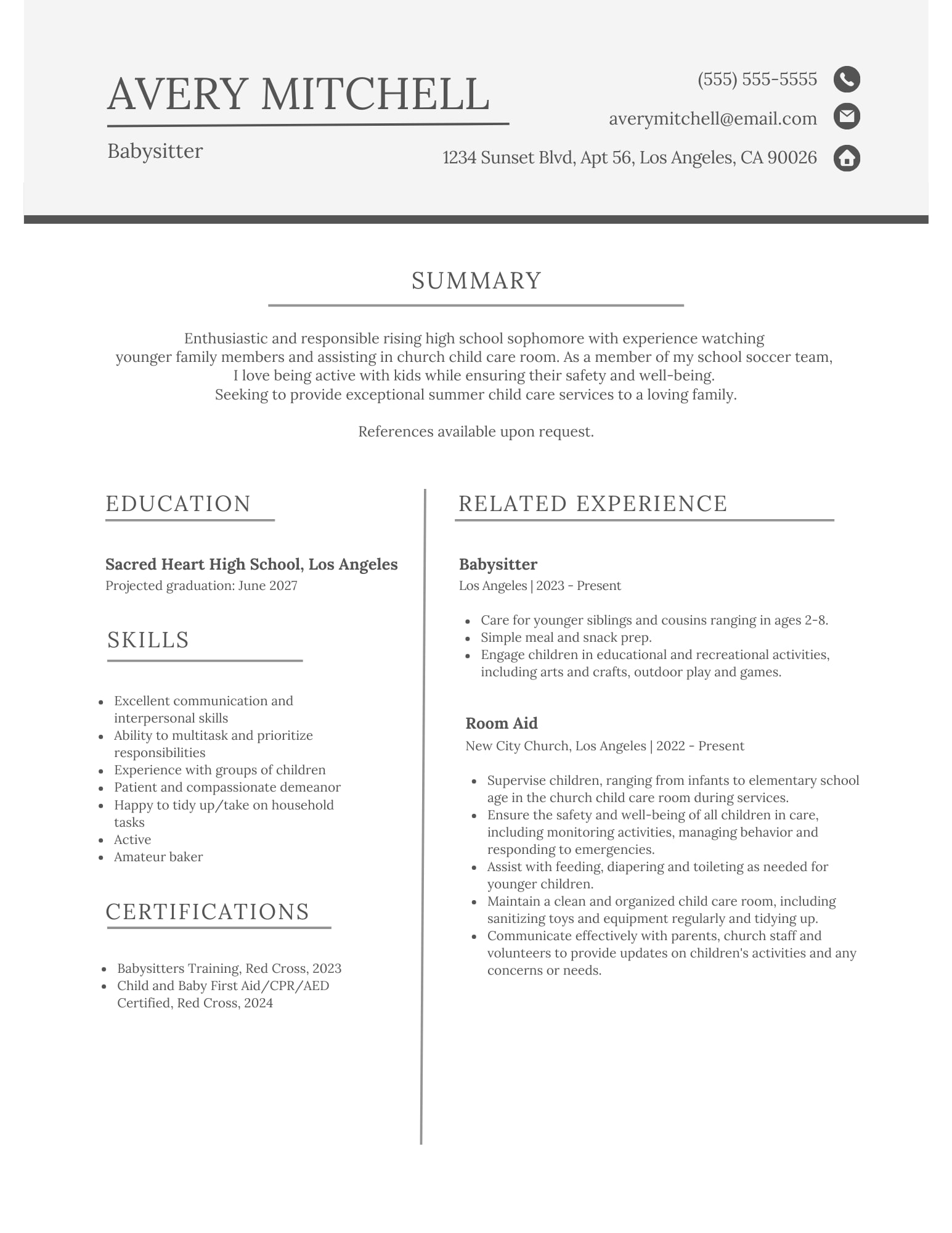In this article
The goal of your babysitting resume is, of course, to make it easier for parents to evaluate and hire you. And the good news is, once you have a babysitter resume, you’re a few steps ahead for every future job because you just add new work skills and experiences going forward.
“Many babysitters don’t have resumes,” says Lydia Thibodeau, founder of Sommet Nannies in Boston. “So, when you take the time to create one, you’re setting yourself apart from the rest while showing you’re detail-oriented and professional.”
The million dollar question, of course, is what to put on your babysitting resume (particularly if you don’t have a ton of experience yet). From unexpected skills to include to babysitting resume examples, here’s everything you need to know about writing and updating your babysitter resume.
Sample babysitter resume template
For reference, here are two babysitting resume examples — one for a more experienced sitter, and one for a babysitter who’s just starting out.
Babysitting resume example for an experienced sitter

(Click to download this babysitter resume template as a PDF.)
Babysitting resume example for a beginning sitter

(Click to download this babysitter resume template as a PDF.)
What to include on a babysitter resume
Here are the five essential sections of information to include on your babysitting resume:
1. Contact information
At the top of your babysitter resume, clearly display your full name and contact information, as well as a professional email address (this isn’t the place for your email with the fun, cutesy handle), mailing address and the best contact phone number for you. If you have a website or professional social profile that showcases your babysitting experience, include that in this section, as well.
2. About yourself
The top of your babysitting resume is prime real estate. Underneath your contact information, include a little information about yourself as a person, as well as the extra tasks you’re willing to take on as a sitter.
“Show that you’re willing to go above and beyond,” Thibodeau says. “It may sound silly, but stating you’re willing to clean up after the kids or help with the dishes is huge. Not all babysitters do this, and it’s an ‘extra’ parents appreciate.”
3. Work experience
You’re applying for a babysitter job, so this is the place to show off all your applicable child care work experience. According to Thidodeau, you should include previous babysitting jobs here, as well as the start/finish dates and the ages of the children.
Take care here not to make each job description “a mirror image,” Thibodeau adds. “Resumes can get bogged down with repetitiveness,” she says. “Instead, include specifics for each, such as whether you cared for kids with special needs, helped with potty training or were responsible for preparing gluten-free meals and snacks.”
Include other related experience that is pertinent to the job, too, especially if you’re just starting out and have limited babysitting experience. For example, if you’ve worked at a summer camp with young children, tutored the neighbor’s child, babysat for family friends on the weekends or even helped raise your siblings, make sure to share these relevant roles.
4. Skills and certifications
In this section, you’ll list any child care training classes you’ve taken, as well as any skills and certifications you possess, such as CPR, water safety or first-aid training or other official designations that help set you apart from other applicants.
Additionally, Thibodeau notes, include any transferable skills or attributes, such as any sports you’ve played (“Families love an active sitter!”), whether you had the same major all four years (“This shows commitment!”) or if you’re an avid baker or crafter (“This shows creativity!”).
If you’re lacking in basic child care training and certifications, consider taking a babysitting class or two to bulk up your credentials.
5. Education
Listing your education on your resume helps the family know more about you and your goals. Include the name of the school, the degree you earned/are earning and graduation year, if applicable. Be sure to note any relevant courses, such as children’s literature or those in early childhood education.
What not to include on a babysitter resume
It may sound counterintuitive, but do not list references directly on your resume. You should be prepared to provide references, but as a general rule, it’s best to leave them off and simply note “References available upon request” at the bottom of your resume.
“This shows you have discretion,” Thibodeau says, “And you’re not willing to share people’s information with anyone.”
An exception to this rule would be if the hiring family specifically requests references up front.
Additions to make your babysitting resume stand out
These items are not required, but including them can help your babysitter resume stand out.
- Cover letter. If you’re going to include a cover letter, Thibodeau says to make it specific to each family, as opposed to an impersonal letter that can be sent to anyone. “You want to convey that you’re specifically choosing them.”
- Professional headshot. Photos should always be professional, notes Briana Murphy of Your Nanny Resume. “Frame the shot from the shoulders up, with a white or blue background and maintain a pleasant smile,” she says. “It’s also advisable to appear solo in the photo without any children present.”
- Photos of any projects you’ve done. “Whether it’s a craft you’ve done with the kids or a beautiful meal, it’s great for families to see your wonderful creations,” says Thibodeau.
Read more:
Common babysitter resume mistakes to avoid
When it comes to building the very best babysitting resume, here are some common “don’ts” to avoid:
- Don’t pick a distracting font or improper formatting. Your resume format should be easy to read. Start by choosing a clean and simple sans serif font, like Calibri or Arial, and opt for black text in size 10 or 12. If you’re emailing your resume, make sure it’s properly formatted and in PDF form. The easier on the eyes, the better.
- Don’t include every job you’ve ever had. Not all work experience needs to be listed on a babysitter resume. If you’ve held a variety of jobs, list only those relevant, such as positions involving child care, education and health and safety.
- Don’t miss the chance to tout your accomplishments. As you begin to craft your babysitter resume, it can be easy to focus solely on the job responsibilities. But don’t forget to highlight your on-the-job accomplishments as well. For example, if you have extensive experience potty training toddlers, don’t just write, “Experienced in potty training toddlers.” Instead, couple both your experience and achievements, like this: “Effectively implemented a variety of potty-training methods, catered to the personality of each child, to successfully teach 15 children, ages 2 and 3, proper bathroom skills.”
- Don’t forget to proofread your resume. There’s nothing worse than a glaring grammatical or spelling error on a resume. Once you have a draft of your resume, read it several times over to catch any errors. Make sure all contact information is correct. Consider asking a trusted friend or family member to proofread your resume and provide feedback. It never hurts to let a second (or even third) pair of eyes review the document.
Keep your babysitter resume fresh going forward
Once you’ve finalized your babysitter resume, be sure to periodically update it as your job experiences and education expands.
“I recommend updating your resume whenever you acquire new skills or receive a promotion,” notes Murphy. “It’s common to become engrossed in your work and overlook the need for resume updates, but by proactively updating your resume, you can avoid forgetting important details.”

